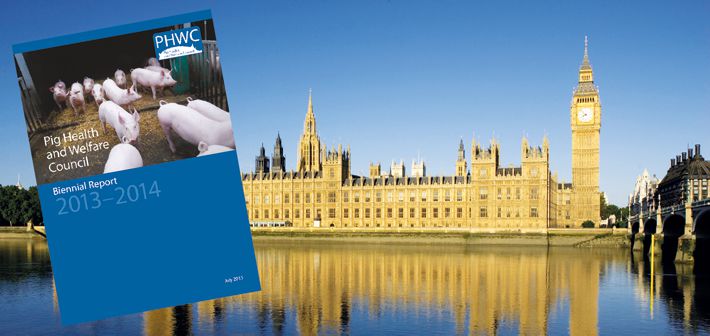Jane Jordan takes a closer look at the Pig Health and Welfare Council’s (PHWC) biennial report for 2013/14, launched in July at the Houses of Parliament
The PHWC has been integral in identifying key challenges and drafting/implementing initiatives that will enable the pig sector to deliver its 20:20 health and welfare strategy. Objectives are being achieved – milestones that will be fundamental in developing future policies for both industry and government.
The vital role the PHWC has had in developing a PEDv contingency plan for England during the past year demonstrates how close collaboration between the pig industry, specialist technicians/allied organisations and other industry stakeholders can bolster tactical objectives and operating procedures. Delivering a robust PEDv strategy has involved considerable assistance from Animal and Plant Health Agency, Defra and the veterinary health sector. The process, underpinned by the council, has proved successful, and is likely to form a blueprint for similar disease contingency measures that might be required going forward.
The PHWC’s indomitable approach in identifying key challenges and promoting practical, workable solutions has also been praised by industry and allied organisations.
The chief executive of the Veterinary Medicines Directorate (VMD), Professor Peter Borriello, said the biennial report was excellent and offered clarity and vision on what the pig sector was aiming to achieve, particularly with respect to medication and long-term disease control programmes.
“This is an exceptional document – a communication tool that can raise significant awareness of this industry’s commitment to improve health status and reduce the level of antibiotics used by its farms,” he said.
Approximately 65% of antibacterial treatments currently used in agriculture are prescribed for pigs. The PHWC’s objective to improve data collection methods and quantify the amount of antimicrobials used by the pig sector in term of “active ingredient” is a significant step forward and fully supported by the VMD.
Prof Borriello added that the information contained in the 2013/14 report must now be promoted beyond the pig business and its allied industries. More people needed to know about these initiatives and how the council was already facilitating change.
He said the next step should be to focus on smart outcomes, because measuring antibiotic use more accurately and evaluating that data against performance indicators and production economics, should help industry justify and possibly defend its use of certain medicines.
The chairman of AHDB Pork, Meryl Ward, agreed and said this was a realistic proposal. The PHWC report provided evidence on how the pig industry was taking a proactive approach in developing strategies that’ll help to safeguard its future. Some of the aims set out by the council’s subgroups might appear ambitious, but they’re rooted in industry, not legislation, and they must be workable and financially viable.
“The AHDB is proud of its investment in PHWC,” she said. “The organisation is an integral part of our pig business and this proactive partnership between cross-industry organisations is important. The close way we work together will continue to underpin success in achieving our 20:20 Pig Health and Welfare Strategy goals,” she said.
The chairman of the Animal Health and Welfare Board for England, Michael Seals, who also heads the National Fallen Stock Company, described the PHWC report as a meaningful vision that would benefit the entire supply chain.
“The outcomes of the strategies detailed here will be better health status, a reduction in endemic disease, increased productivity and less antibiotic use alongside improvements to pig welfare and food safety,” he said.
Mr Seals firmly believed that other livestock sectors should follow the pig industry’s proactive, cross-sector approach to health protection, disease control and animal welfare. Collaborative strategies, he said, offered real solutions to many of the challenges facing livestock production. It also sent out clear signals to UK and European government that these issues were being addressed, and that the voluntary actions taken by industry needed to be recognised within policy-making processes.




